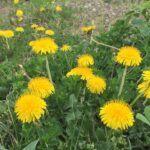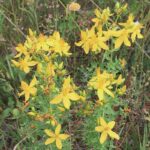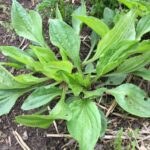WHEN WE ATE WEEDS
There are the plants we love – tulips and daffodils, wildly orange lilies, and fragrant roses. Among our favorites are those we love to eat, like carrots and cabbage, lettuce and tomatoes. Then there are weeds, and we all know about weeds. Don’t we?

As a kid in New York City, I picked bright dandelions that pushed up through sidewalk cracks, and stripped seeds from plantain and yellow dock that sprouted everywhere along the Staten Island shoreline. I was never scolded for this because they were nuisance plants, after all.
Dandelions, plantain, crab grass and quack grass. Their very existence is a major thorn in the side of anyone intent upon a pristine lawn. On the other hand, those never-say-die weeds add jingle to the pockets of every chemical company selling lawn and garden herbicides, pesticides, and fertilizers.
According to a 2017 EPA report[1], the most recent available, U.S. pesticide usage totaled over 1.1 billion pounds annually in both 2011 and 2012, with herbicides accounting for nearly 60% of usage in 2012. This covers applications to agricultural land, residences, and commercial settings.
The 2019 edition Lawn and Garden Consumables forecast the demand for fertilizers to grow 2.6% annually to $3.3 billion in 2023. This includes residences and golf courses, as well as government and private campuses. Why this obsession with lawn grass and against weeds? Believe it or not, it dates back to the first European settlers. They brought in grass seed as their cattle began to decimate the natural forages, and because they provided families with the first fresh greens in spring. Both Presidents Washington and Jefferson were fans of the European fascination with manicured lawns (maintained by slave labor). Lawns became symbols of wealth, civic responsibility (killing every weed in sight), and neighborly homogeneity. The inventions of irrigation systems and the mower made grooming a lawn more attractive, as did the sprouting of golf courses across the nation. Lawn care was dramatically promoted as World War II veterans came home and bought houses complete with patches of green. Easy access to lawn and garden chemicals helped make grass-keeping a weekend obligation.
In the last 20 years or so, we’ve become increasingly concerned about the negative impacts of these chemicals on our wetlands, farm lands, lakes and rivers. A very large cultural tension exists, however, between our desire to remedy this situation and this deeply ingrained symbol of well-healed home ownership — the lush, weed-free lawn.
 As a farmer, I understand weeds can seriously reduce productivity by starving food crops of moisture, nutrients and even sunlight. Because some weeds can be harmful to grazing animals, I hand pull St. John’s Wort from my pastures. At the same time, I encourage the sunny patches that grow behind my house because the flowers are healthful additions to my medicine chest.
As a farmer, I understand weeds can seriously reduce productivity by starving food crops of moisture, nutrients and even sunlight. Because some weeds can be harmful to grazing animals, I hand pull St. John’s Wort from my pastures. At the same time, I encourage the sunny patches that grow behind my house because the flowers are healthful additions to my medicine chest.
Regenerative farmers use a variety of natural and mechanical approaches to suppress weeds and keep soil healthy. They also use management techniques, such as when to plant, spacing in rows, and companion planting to achieve their goals. Farm Table purchases produce and protein from these farms because they take this care.
So, what to do? There are several approaches available to homeowners and gardeners. We can
- Choose organic pest controls and fertilizers
- Select plant varieties best suited to our soil conditions and climate, thereby avoiding the need for artificial chemical boosters
- Re-frame our thinking: weeds as desired crop
Dandelions were introduced by European colonists over 400 years ago and now grow everywhere. The young leaves, though slightly bitter, are good in soups, salads, and smoothies. They provide vitamins A, B and C, iron, potassium, calcium, and zinc. Dandelion’s bitterness helps get our digestive juices going and support liver function, helpful qualities as we move out of winter’s heavy meals.

As dandelions emerge, so do burdock and yellow/curly dock. Their roots have been used as food and health supplement for generations. Burdock root, called gobo in Japan, is poplar in stir fries.

You can mash plantain leaves and use the paste to calm itchy skin or an insect bit. Stinging nettles are delicious sauteed in olive oil and garlic. They’re also great on pizza and alongside scrambled eggs.
Last week I opened the Foundation’s back door to happily receive a large bag of fresh nettles and another of ramps (wild garlic leaves). Chef Sarah transformed the nettles into a delicious creamy soup served with a dollop of cream cheese whipped with lemon juice and chives. Heaven.
That weed in your garden? Take a closer look. It may become a very welcome addition to your seasonal larder.
I hope to see you at Farm Table soon.
Sylvia Burgos Toftness, Interim Executive Director, [email protected]
Note: There are hundreds of books, dozens and dozens of websites, and just as many YouTube channels about foraging wild foods. Here are three from my bookshelf:
- The Foragers Harvest by Samuel Thayer
- Incredible Edibles by Samuel Thayer
- The Foragers Guide to Wild Foods by Claude Davis and Nicole Apelian, Ph.D.
- Pesticide Industry Sales and Usage: 2008-2012 Estimates, US Environmental Protection Agency, January 2017.
